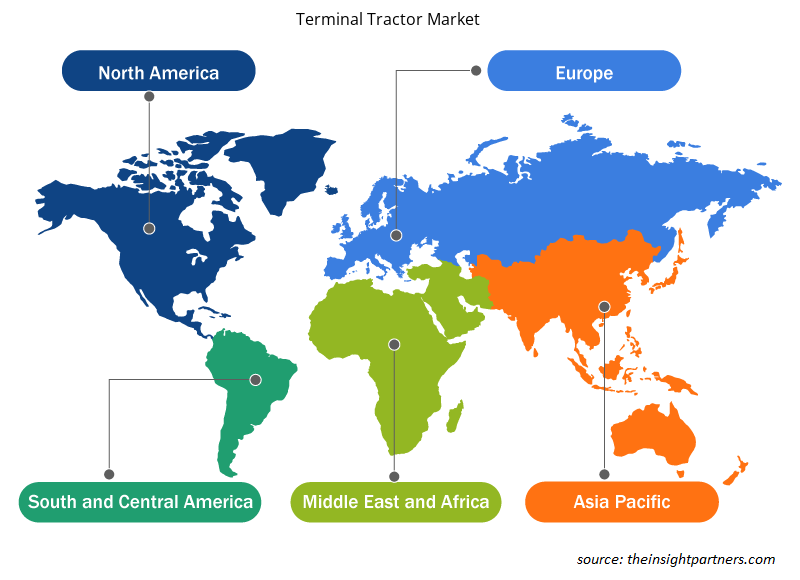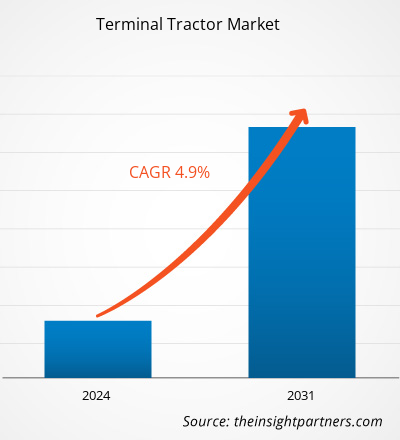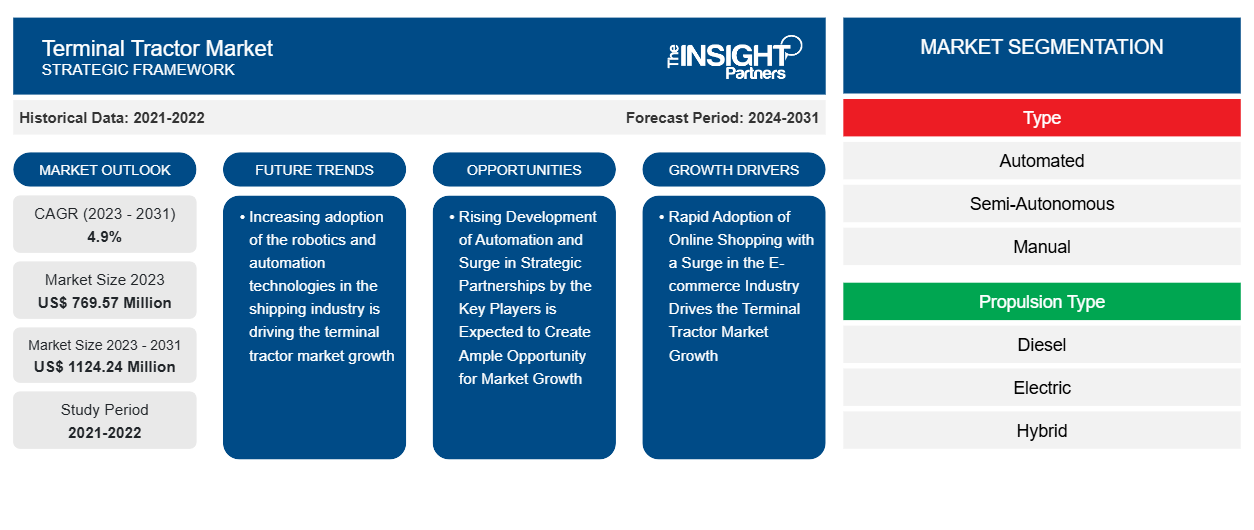Si prevede che la dimensione del mercato dei trattori terminali raggiungerà 1124,24 milioni di $ entro il 2031 da 769,57 milioni di $ nel 2023. Si prevede che il mercato registrerà un CAGR del 4,9% nel 2023-2031. Il mercato dei trattori terminali è guidato dalla crescente domanda di merci da parte del settore dell'e-commerce. Inoltre, l'aumento della domanda di soluzioni di movimentazione merci su navi, terminal, porti e centri di distribuzione locali è un importante fattore trainante per la crescita del mercato dei trattori terminali. Questi trattori offrono elevata affidabilità e maggiore capacità di spedizione e sono in grado di trasportare merci ingombranti in modo efficiente. Secondo la Conferenza delle Nazioni Unite sul commercio e lo sviluppo ( UNCTAD ), nel 2021 sono stati movimentati più di 849,5 milioni di container equivalenti a venti piedi nei porti di tutto il mondo.
Analisi di mercato dei trattori terminali
I produttori di trattori terminali si concentrano sullo sviluppo di nuovi prodotti e sul lancio di diversi prodotti per rimanere competitivi nel mercato globale dei trattori terminali. I produttori del mercato dei trattori terminali stanno enfatizzando l'adozione di caratteristiche e funzionalità avanzate nei loro prodotti per migliorarne l'ambito di applicazione. L'aumento di fusioni, partnership, collaborazioni e acquisizioni che aiutano i produttori di trattori terminali ad espandere la loro presenza sul mercato in tutto il mondo sta creando ampie opportunità di crescita del mercato. Le aziende di trattori terminali offrono partnership con operatori logistici, magazzinieri, compagnie di spedizione e società commerciali per garantire strutture di trasporto per aumentare i ricavi a lungo termine.
Panoramica del mercato dei trattori terminali
I fornitori di servizi logistici in tutto il mondo utilizzano ampiamente i trattori terminali. Il crescente settore della logistica, con l'avvento del settore dell'e-commerce a un ritmo rapido, è un fattore trainante importante per la crescita del mercato dei trattori terminali durante il periodo di previsione. I trattori terminali sono veicoli industriali di Classe 8 utilizzati per trasportare semirimorchi, container di spedizione carichi e vuoti per brevi distanze in modo efficiente e rapido. Sono comunemente utilizzati in magazzini, porti di spedizione, merci, terminal per camion e strutture di cross-dock e sono configurati per applicazioni sia fuoristrada che su strada. Sono noti con nomi diversi, come yard truck, yard jockey, spotter truck, yard hosteler e shunt truck. Le sue caratteristiche includono un singolo offset della cabina con visibilità migliorata per il conducente, un passo corto per il raggio di sterzata e porte scorrevoli per i conducenti.
Personalizza questo report in base alle tue esigenze
Riceverai la personalizzazione gratuita di qualsiasi report, comprese parti di questo report, o analisi a livello nazionale, pacchetto dati Excel, oltre a usufruire di grandi offerte e sconti per start-up e università
-
Scopri le principali tendenze di mercato in questo rapporto.Questo campione GRATUITO includerà analisi di dati che spaziano dalle tendenze di mercato alle stime e alle previsioni.
Driver e opportunità del mercato dei trattori terminali
La rapida adozione dello shopping online con un'impennata nel settore dell'e-commerce guida la crescita del mercato dei trattori terminali
L'industria dell'e-commerce in rapida crescita ha creato una domanda enorme di trattori terminali globali per gestire le consegne dei pacchi e gli utenti finali. La crescente domanda di acquisti online, insieme alla rapida crescita della penetrazione di Internet a livello globale, è un importante fattore trainante per la crescita del mercato dei trattori terminali. Le vendite del settore dell'e-commerce negli Stati Uniti, valutate a 1,12 trilioni di dollari nel 2023, sono aumentate di circa il 7,6% rispetto a 1,03 trilioni di dollari nel 2022. Nel frattempo, le vendite dell'e-commerce in tutto il mondo sono state valutate a 5,08 trilioni di dollari nel 2023, con un aumento del 3,8% rispetto al 2022. Questa rapida adozione dello shopping online con l'impennata del settore dell'e-commerce in tutto il mondo guida la crescita del mercato dei trattori terminali durante il periodo di previsione.
Con la rapida espansione del settore dell'e-commerce, è aumentata anche la domanda di trattori da terminal per il trasporto di pacchi e merci. I principali settori che guidano la crescita del mercato dei trattori da terminal includono la nautica, i prodotti farmaceutici, la vendita al dettaglio, i prodotti alimentari e le bevande. Inoltre, la crescita del mercato dei trattori da terminal è guidata dall'impennata dei beni di consumo in rapida evoluzione che guidano la crescita del mercato dei trattori da terminal durante il periodo di previsione.
Si prevede che il crescente sviluppo dell'automazione e l'aumento delle partnership strategiche da parte dei principali attori creeranno ampie opportunità di crescita del mercato
I principali attori del mercato dei trattori terminali coinvolgono partnership strategiche per soddisfare la domanda dei consumatori. Ad esempio, nell'agosto 2022, Kalmar, la divisione commerciale di Cargotec, ha stretto una partnership con Maldives Ports Ltd. per offrire a T2i tre trattori terminali. L'acquisto è stato effettuato dall'assunzione di Cargotec e consegnato nel primo trimestre del 2023.
- A luglio 2022, Kalmar ha stretto una partnership con Helsingborg Ports Ltd. per offrire il terminale trattore elettrico Kalmar Reachstacker. L'accordo include la formazione per l'adozione del terminale trattore, gli operatori delle attrezzature e i requisiti di manutenzione.
- A giugno 2022, Terberg ha lanciato trattori elettrici completamente automatizzati. Si tratta di un design autonomo progettato per il traffico misto. È un trasporto autonomo efficiente e sicuro.
- Nel gennaio 2022, Kalmar ha stretto una partnership con Coast Autonomous Inc. per lanciare il portafoglio robotico avanzato di Kalmar. I prodotti consistono in soluzioni di apparecchiature mobili intelligenti pensate per aumentare la produttività del trasporto merci e della movimentazione dei materiali.
Analisi della segmentazione del rapporto di mercato dei trattori terminali
I segmenti chiave che hanno contribuito alla derivazione dell'analisi di mercato dei trattori terminali sono tipologia, piattaforma, applicazione e utente finale.
- In base al tipo, il mercato è suddiviso in automatizzato, semi-autonomo e manuale. Tra questi, il manuale ha la quota maggiore nel 2023, e ciò è dovuto all'aumento della domanda nel settore della logistica e della distribuzione a un ritmo rapido,
- A seconda del tipo di propulsione, il mercato è diviso in diesel , elettrico, ibrido e CNG. Tra questi, il CNG sta crescendo a un ritmo rapido grazie alla maggiore efficienza e alla domanda aumentata per il settore della logistica.CNG. Among these, CNG is growing at a rapid pace owing to higher efficiency and increased demand for the logistics sector.
- In base all'applicazione, il mercato dei trattori terminali è suddiviso in movimentazione dei materiali, logistica e distribuzione, aeroporti, terminal container e altri. Tra questi, il settore della logistica e della distribuzione ha la quota maggiore nel 2023.
Analisi della quota di mercato dei trattori terminali per area geografica
L'ambito geografico del rapporto sul mercato dei trattori terminali è suddiviso principalmente in cinque regioni: Nord America, Europa, Asia Pacifico, Medio Oriente e Africa e Sud America.
Si prevede che il Nord America avrà la quota maggiore nel 2023 e gli Stati Uniti stanno crescendo a un ritmo rapido durante il periodo di previsione. Questa crescita è dovuta alla presenza di importanti produttori come Kalmar, Inc., REV Group Inc., Terberg e Mol. Inoltre, gli investimenti crescenti con l'impennata nell'adozione delle ultime tecnologie nel settore della logistica e dell'immagazzinamento in questa regione stanno guidando la crescita del mercato dei trattori terminali.
L'Asia Pacifica sta crescendo al CAGR più alto durante il periodo di previsione a causa del crescente predominio degli operatori cinesi nella spedizione di container in Cina. Inoltre, il crescente settore dell'e-commerce, l'emergere della globalizzazione, l'evoluzione dell'industria 4.0 e l'adozione di fabbriche intelligenti nelle nazioni in via di sviluppo nella regione Asia Pacifica guidano la crescita del mercato dei trattori terminali durante il periodo di previsione.CAGR during the forecast period owing to the rising dominance of Chinese players to ship containers in China. Also, the rising E-commerce sector, the emergence of globalization, industry 4.0 evolution, and the adoption of smart factories across the developing nations in the Asia Pacific region drive the terminal tractor market growth during the forecast period.
Anche l'Europa sta crescendo a un ritmo considerevole nel periodo di previsione, a causa della domanda di prodotti per trattori terminali da parte di paesi importanti come Italia, Francia, Germania e Regno Unito.
Approfondimenti regionali sul mercato dei trattori terminali
Le tendenze regionali e i fattori che influenzano il mercato dei trattori terminali durante il periodo di previsione sono stati ampiamente spiegati dagli analisti di Insight Partners. Questa sezione discute anche i segmenti e la geografia del mercato dei trattori terminali in Nord America, Europa, Asia Pacifico, Medio Oriente e Africa e America meridionale e centrale.

- Ottieni i dati specifici regionali per il mercato dei trattori terminali
Ambito del rapporto sul mercato dei trattori terminali
| Attributo del report | Dettagli |
|---|---|
| Dimensioni del mercato nel 2023 | 769,57 milioni di dollari USA |
| Dimensioni del mercato entro il 2031 | 1124,24 milioni di dollari USA |
| CAGR globale (2023-2031) | 4,9% |
| Dati storici | 2021-2022 |
| Periodo di previsione | 2024-2031 |
| Segmenti coperti |
Per tipo
|
| Regioni e Paesi coperti |
America del Nord
|
| Leader di mercato e profili aziendali chiave |
|
Densità dei player del mercato dei trattori terminali: comprendere il suo impatto sulle dinamiche aziendali
Il mercato dei trattori terminali sta crescendo rapidamente, spinto dalla crescente domanda degli utenti finali dovuta a fattori quali l'evoluzione delle preferenze dei consumatori, i progressi tecnologici e una maggiore consapevolezza dei vantaggi del prodotto. Con l'aumento della domanda, le aziende stanno ampliando le loro offerte, innovando per soddisfare le esigenze dei consumatori e capitalizzando sulle tendenze emergenti, il che alimenta ulteriormente la crescita del mercato.
La densità degli operatori di mercato si riferisce alla distribuzione di aziende o società che operano in un particolare mercato o settore. Indica quanti concorrenti (operatori di mercato) sono presenti in un dato spazio di mercato in relazione alle sue dimensioni o al valore di mercato totale.
Le principali aziende che operano nel mercato dei trattori terminali sono:
- Azienda
- Konecranes Oyj
- Gruppo Sany
- Gruppo Terberg BV
- Hyster-Yale Materials Handling, Inc.
- MAFI Transport-Systeme GmbH
Disclaimer : le aziende elencate sopra non sono classificate secondo un ordine particolare.

- Ottieni una panoramica dei principali attori del mercato dei trattori terminali
Notizie e sviluppi recenti sul mercato dei trattori terminali
Il mercato dei trattori terminali viene valutato raccogliendo dati qualitativi e quantitativi dopo la ricerca primaria e secondaria, che include importanti pubblicazioni aziendali, dati associativi e database. Di seguito è riportato un elenco degli sviluppi nel mercato per il mercato dei trattori terminali e delle strategie:
- Ad agosto 2022, Kalmar, che fa parte di Cargotec, ha ottenuto l'accordo di fornitura per i tre trattori da terminal T2i presso Maldives Port Limited. La consegna degli ordini è prevista entro il primo trimestre del 2023. (Fonte: DJI, comunicato stampa/sito Web aziendale/newsletter)
- A giugno 2022, il terminal della Costa d'Avorio ha annunciato la consegna di 14 nuovi trattori terminali elettrici APM 75T HE forniti da Gaussin per l'utilizzo dei servizi di trasporto presso il porto di Abidjan. Tuttavia, l'ordine è stato effettuato per 36 unità di trattori terminali, che sono state fornite in fasi entro l'ultimo trimestre del 2022. (Fonte: DJI, comunicato stampa/sito Web aziendale/newsletter)
Copertura e risultati del rapporto sul mercato dei trattori terminali
Il rapporto "Dimensioni e previsioni del mercato dei trattori terminali (2021-2031)" fornisce un'analisi dettagliata del mercato che copre le seguenti aree:
- Dimensioni e previsioni del mercato a livello globale, regionale e nazionale per tutti i segmenti di mercato chiave coperti dall'ambito
- Dinamiche di mercato come fattori trainanti, vincoli e opportunità chiave
- Principali tendenze future
- Analisi PEST dettagliata
- Analisi di mercato globale e regionale che copre le principali tendenze di mercato, i principali attori, le normative e gli sviluppi recenti del mercato
- Analisi del panorama industriale e della concorrenza che copre la concentrazione del mercato, l'analisi della mappa di calore, i principali attori e gli sviluppi recenti
- Profili aziendali dettagliati con analisi SWOT
- Analisi storica (2 anni), anno base, previsione (7 anni) con CAGR
- Analisi PEST e SWOT
- Valore/volume delle dimensioni del mercato - Globale, Regionale, Nazionale
- Industria e panorama competitivo
- Set di dati Excel
Report recenti
Testimonianze
Motivo dell'acquisto
- Processo decisionale informato
- Comprensione delle dinamiche di mercato
- Analisi competitiva
- Analisi dei clienti
- Previsioni di mercato
- Mitigazione del rischio
- Pianificazione strategica
- Giustificazione degli investimenti
- Identificazione dei mercati emergenti
- Miglioramento delle strategie di marketing
- Aumento dell'efficienza operativa
- Allineamento alle tendenze normative























 Ottieni un campione gratuito per - Mercato dei trattori terminali
Ottieni un campione gratuito per - Mercato dei trattori terminali